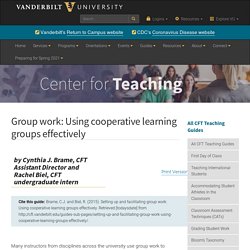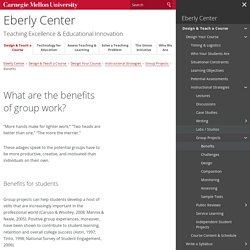

Team Roles. A team is not a bunch of people with job titles, but a congregation of individuals, each of whom has a role which is understood by other members.

Research showed that the most successful teams were made up of a diverse mix of behaviours. Dr Meredith Belbin and his team discovered that there are nine clusters of behaviour - these were called ' Belbin Team Roles' (see descriptions below). Each team needs access to each of the nine Belbin Team Role behaviours to become a high performing team. However, this doesn't mean that every team requires nine people! Most people will have two or three Belbin Team Roles that they are most comfortable with, and this can change over time. However, not all are always required at the same time - it is important to first look at the team objectives, and work out which tasks need to be undertaken.
By using Belbin, individuals have a greater self-understanding of their strengths, which leads to more effective communication between colleagues and managers. The Extraordinary Teaching Project: Group Work Strategies from a Group Processes Expert. Why we need group work in Online Learning. This post is 1st in a 3 part series on the topic of group work in online learning communities.

Post 2 will be about strategies for effective group work, and post 3, successful evaluation and outcomes Group work. Students groan when they find out there’s a group assignment that’s part of the grading for a given class [ I’m no exception]. Students learning online don’t feel much different, and given the time and distance barriers, it presents even more challenges for these students. What is it about group work that is so distasteful? The future IS Collaboration Collaboration goes beyond, two or more people working together towards a common goal – in today’s terms, collaboration is about open, learning, relationships, sharing and innovation. 1. Collaborative skills, developed through effective communication in online environments is, and will be essential to workplaces in the 21st century. 2. Where do Ideas come From? 3. Like this: Making Group Work Work in an Intercultural Class. Working definitions of “intercultural class” and “intercultural students”:An intercultural class is comprised of students who are “linguistically, culturally, socially and in other ways, different from the instructor or from each other” (Dimitrov, Dawson, Olsen, & Meadows, 2014).

Coming from other countries, intercultural students have limited to no exposure to Canadian academia and are working on adjusting to the higher education system in Canada. There is one type of assignment that every student and instructor would have a lot to say-may that be over-the-moon positive, down-in-the-dumps negative, or a mix of both. Yes, you’ve guessed it-it’s group work. Making Groupwork Work. Skip to content Skip to navigation Complex Instruction Videos.

Group work: Using cooperative learning groups effectively. Many instructors from disciplines across the university use group work to enhance their students’ learning.

Whether the goal is to increase student understanding of content, to build particular transferable skills, or some combination of the two, instructors often turn to small group work to capitalize on the benefits of peer-to-peer instruction. This type of group work is formally termed cooperative learning, and is defined as the instructional use of small groups to promote students working together to maximize their own and each other’s learning (Johnson, et al., 2008). Cooperative learning is characterized by positive interdependence, where students perceive that better performance by individuals produces better performance by the entire group (Johnson, et al., 2014).
It can be formal or informal, but often involves specific instructor intervention to maximize student interaction and learning. What can it look like? Group Work Strategies from a Group Processes Expert. Professor Bianchi teaches some of her classes in the University of Iowa’s active-learning TILE classrooms, which have round tables to facilitate group work.

Instructors in other kinds of classrooms can encourage students to manage their physical space by moving desks, chairs, or themselves so that all group members can work face-to-face with every member contributing. Students will be motivated to participate when group assignments are deliberately calibrated to require real collaboration. Groupwork is most appropriate when the task requires higher-level conceptual thinking that requires the skills and ideas of multiple students. Individual projects masquerading as group projects can result in a single student either taking over the work or having to pick up the slack from other students.
Using Group Projects Effectively - Eberly Center. Eberly Center › Design & Teach a Course › Design Your Course › Instructional Strategies › Group Projects Using Group Projects Effectively If structured well, group projects can promote important intellectual and social skills and help to prepare students for a work world in which teamwork and collaboration are increasingly the norm.

This section provides advice for faculty employing group projects. We examine the following questions: This site supplements our 1-on-1 teaching consultations. What are the benefits of group work? - Teaching Excellence. “More hands make for lighter work.”

“Two heads are better than one.” “The more the merrier.” These adages speak to the potential groups have to be more productive, creative, and motivated than individuals on their own. Benefits for students Group projects can help students develop a host of skills that are increasingly important in the professional world (Caruso & Woolley, 2008; Mannix & Neale, 2005). Group Work Strategies to Ensure Students Pull Their Weight. Best online collaboration software of 2020: paid and free tools for work sharing and communication. The spread of the coronavirus (aka COVID 19) has led companies around the world to accommodate remote working, helping reduce the spread of the virus while also aiming to limit the impact on productivity.

Here we feature the best in collaboration software, allowing employees to work remotely from home while still being able to directly communicate and collaborate on projects and documents. For everything else, check out our best video conferencing software if you're in need of a new way to stay in touch. Best online collaboration software Collaboration is the new normal in the workplace, with employees no longer expected to work cut off from one another. This focus on collaboration should mean improved efficiency and increased productivity, but can only be achieved if you have the best online collaboration tools in the first place. Even better, deadlines, task management, and support should all be built into communications. Best online collaboration software - at a glance 1. 31 Best Online Collaboration Tools (Tried & Tested) In 2021.
Online collaboration tools empower employees to work together on projects from anywhere in the world.

At SnackNation, we believe that collaboration and transparency are two key components to the modern workplace experience. Our teams harness the power of the best online collaboration tools to help increase productivity and efficiency. Remote working conditions (or aspects of it) have become commonplace in today’s workplace. And with this kind of shift, it is more urgent than ever for organizations to leverage the best online collaboration tools to keep their teams on the same page at all times.
When Group Work Doesn’t Work: Insights from Students. CAS Authentication wanted! Fostering a dynamic and interactive atmosphere for your blended or online class can be difficult. If the well is dry, this article has a large variety of suggestions to help stimulate discussion and participation among your students. “Social presence is defined as the ability of participants in a community to project themselves, socially and emotionally, as real people through a medium of communication,” (Garrison and Anderson, 2003).
In thinking about a community of learners, let us tie in one of the major themes of Lev Vgotsky’s Social Development Theory. Vygotsky’s theory asserts that “social interaction plays a fundamental role in the process of cognitive development.” In essence, social presence is a critical element in the learning process. Social Presence and Interaction – the Instructor The course is all built, the students are busy working on assignments, now what do I do? Team Roles Test. 5 Tips for Dealing with Lazy Group Project Members - College Info Geek. EJ1152959.